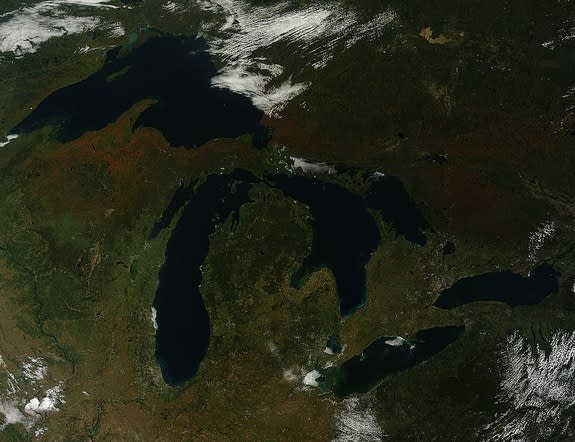Fall Colors Spotted from Space (Photos)
Pictures from space show that fall is in full swing in parts of North America. Clusters of trees have shed their summer greens in favor of autumnal oranges and reds around the Great Lakes and New England.
NASA's Terra satellite went leaf peeping last week from its perch about 438 miles (705 kilometers) above the planet.
The Earth-watching satellite captured the fall colors spreading around the Great Lakes on Friday (Sept. 26) and New England on Saturday (Sept. 27) using its Moderate Resolution Imaging Spectroradiometer, or MODIS. The images were released today (Sept. 30) by NASA's Earth Observatory. [In Photos: Fall Foliage Seen from Space]
As the Earth Observatory notes, the brown and orange hues are currently most prominent in Michigan's Upper Peninsula, northern Wisconsin, upstate New York, New Hampshire, Vermont, Maine, and southern Quebec and Ontario. The images also show traces of phytoplankton blooms in the Great Lakes and off the North Atlantic coast.
Fall officially began last Monday (Sept. 22) with the autumnal equinox. Chillier temperatures and shorter days cause leaves to quit producing chlorophyll, the green-tinted pigment that allows plants to capture sunlight and make energy.
With chlorophyll out of the picture, other pigments in the leaves have a chance to shine. Carotenes and xanthophyll pigments appear yellow to orange. Meanwhile, fiery reds and deep purple leaf colors come from anthocyanins, which are exclusively produced in the fall in response to stress. These pigments act like sunscreen for leaves, blocking out damaging radiation and providing protection from excess light.
A tree's fall wardrobe depends on its species. The U.S. Forest Service notes that oaks tend to turn red, brown, or russet, while hickories go golden bronze. Red maples turn scarlet, sugar maples change to orange-red, and black maples go yellow.
Climate change might affect the way leaf-peeping season shakes out in the future. Simulations featured in the Climate Change Tree Atlas show how some populations of fall favorites might shift. Sugar maples, for example, might be nudged from New England to Canada as their suitable habitat in the United States shrinks over the next century.
Climate change might also postpone the onset of leaf-color changes and leave fall hues lingering later into the year. For instance, the paper birch tree in New Hampshire might change color one to three weeks later by the end of the century, a recent study from Princeton University found.
Follow Megan Gannon on Twitter and Google+. Follow us @livescience, Facebook & Google+. Original article on Live Science.
Copyright 2014 LiveScience, a TechMediaNetwork company. All rights reserved. This material may not be published, broadcast, rewritten or redistributed.



